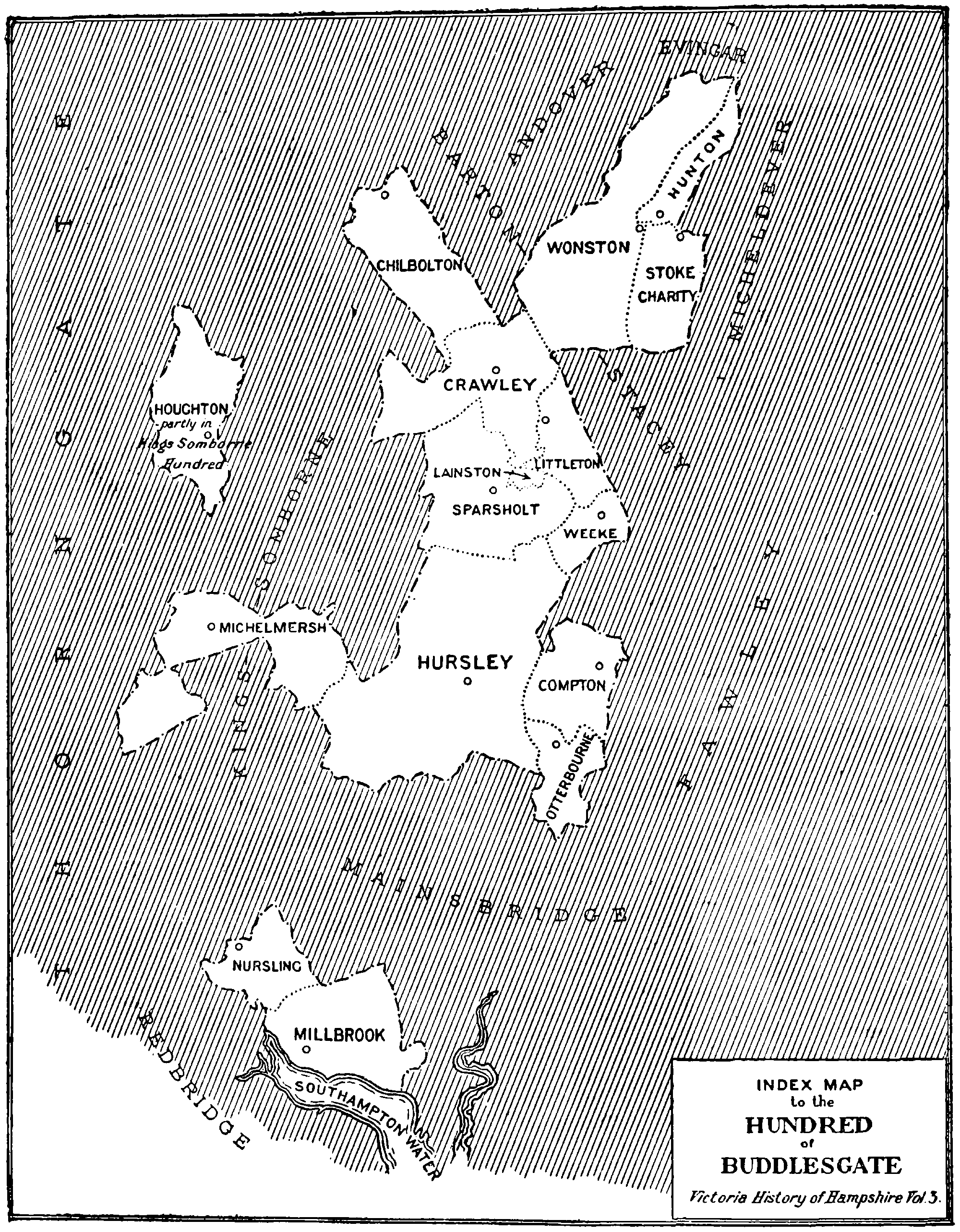A History of the County of Hampshire: Volume 3. Originally published by Victoria County History, London, 1908.
This free content was digitised by double rekeying. All rights reserved.
'The hundred of Buddlesgate: Introduction', in A History of the County of Hampshire: Volume 3, ed. William Page( London, 1908), British History Online https://prod.british-history.ac.uk/vch/hants/vol3/pp400-402 [accessed 28 November 2024].
'The hundred of Buddlesgate: Introduction', in A History of the County of Hampshire: Volume 3. Edited by William Page( London, 1908), British History Online, accessed November 28, 2024, https://prod.british-history.ac.uk/vch/hants/vol3/pp400-402.
"The hundred of Buddlesgate: Introduction". A History of the County of Hampshire: Volume 3. Ed. William Page(London, 1908), , British History Online. Web. 28 November 2024. https://prod.british-history.ac.uk/vch/hants/vol3/pp400-402.
THE HUNDRED OF BUDDLESGATE
CONTAINING THE PARISHES OF
| CHILBOLTON | LITTLETON |
SPARSHOLT Lainston Extra-Parochial |
| COMPTON | MICHELMERSH | |
|
CRAWLEY Hunton Chapelry |
MILLBROOK | STOKE CHARITY |
| NURSLING |
WEEKE and |
|
| HOUGHTON | OTTERBOURNE | |
| HURSLEY | WONSTON | |
The above list represents the extent of the hundred at the time of the Population Returns of 1831. The parishes of Ashley and Little Somborne were added to the hundred before 1841, and probably at the same time the parishes of Chilbolton, Houghton, Michelmersh, Millbrook, and Nursling were transferred respectively to the hundreds of Wherwell, King's Somborne, Thorngate, Mainsbridge, and Redbridge. (fn. 1)
In the Domesday Survey the hundred of Buddlesgate or 'Bitelesiete,' as it is there called, included Chilbolton, (fn. 2) Crawley, (fn. 3) Nursling, (fn. 4) and part of Otterbourne. (fn. 5) The total assessment before the Conquest was 28½ hides, which by 1086 had decreased to 21½. (fn. 6) The parishes of Compton, Littleton, Sparsholt, and Weeke, as parcels of the great manor of Chilcomb, were probably included in the entry of that manor under the heading of the hundred of 'Falemere,' (fn. 7) which is probably an error for 'Falelie,' the modern Fawley. King's Somborne Hundred included Houghton (fn. 8) and the tithing of Awbridge in the parish of Michelmersh, (fn. 9) and Mainsbridge Hundred, the entire parish of Millbrook (fn. 10) and the tithing of Boyatt in the parish of Otterbourne, (fn. 11) while Wonston formed part of the hundred of Barton Stacey. (fn. 12) Stoke Charity is entered, perhaps wrongly, under Meon Hundred, (fn. 13) while the parishes of Hursley and Michelmersh are not mentioned. In the fourteenth century the area of the hundred had greatly increased, comprising as it did Hursley with the dependent hamlets of Ampfield, Pucknall, Merdon, Standon, Pitt, West Pitt, and Silkstead, Michelmersh with the tithing of Awbridge, (fn. 14) Stoke Charity, (fn. 15) Compton with the hamlet of Sparkford, Nursling, Weeke with the hamlet of Fullflood, Sparsholt, Littleton, Crawley with the chapelry of Hunton, and Chilbolton, parts of the parishes of Otterbourne, Millbrook, and Wonston, the tithings of Houghton Drayton in the parish of Houghton, and Bransbury in the parish of Barton Stacey, (fn. 16) and parts of knights' fees in Wishanger and Newton. (fn. 17) The vills of Boyatt, and Shirley in Millbrook, were still included in the hundred of Mainsbridge, (fn. 18) and Sutton Scotney and Norton Valery in the parish of Wonston in that of Barton Stacey; (fn. 19) Cranborne, also in Wonston, was in the hundred of Micheldever, (fn. 20) while the tithing of North Houghton in the parish of Houghton was included in the hundred of King's Somborne. (fn. 21) The area of the hundred thus underwent but little change until the beginning of the nineteenth century, the only alterations consisting in the addition of some tithings and the removal of others. In 1831 the tithing of North Houghton was still in the hundred of King's Somborne. The hundred was the property of the prior and convent of St. Swithun, Winchester, (fn. 22) and passed with much of their property to the dean and chapter at the Dissolution.

INDEX MAP to the HUNDRED of BUDDLESGATE
